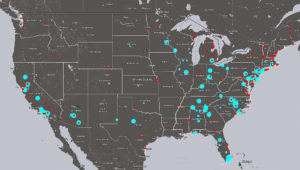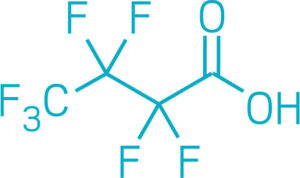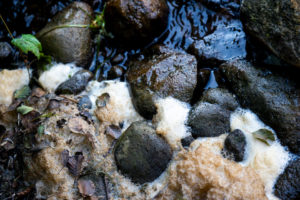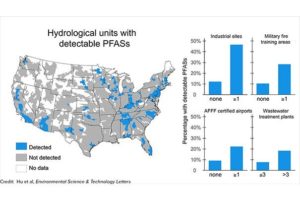Environment

What Are PFAS? Why Should We Be Worried About Them?
PFAS are chemicals we come in contact with almost every day, but never truly think about. So, we dove a little deeper into PFAS and how they affect us.

We’ve talked about the contaminated water in Bucks and Montgomery County, PA before in a blog posted back in August, where we touched lightly on what PFAS are. Now we’re going to dive a little deeper into what they are, where they come from and how they can affect us to help the public stay informed.
According to the Bucks County Courier Times, these “forever chemicals”, “have been found in nationally high levels in Bucks and Montgomery County communities, linked to a trio of current and former military bases in Horsham and Warminster.” And “Until now [February 2020], the agency [the EPA] has come under fire from environmentalists for only setting a nonbinding health threshold of 70 parts per trillion for PFOA and PFOS in drinking water. Several states have responded by setting their own PFAS limits for drinking water that are far tougher than the federal guidance.”
What Are PFAS?
Let’s start with what PFAS are. PFA stands for per/poly-fluoroalkyl substances. According to the EPA, “per – and polyfluoroalkyl substances are a group of man-made chemicals that includes PFOA, PFOS, GenX, and many other chemicals” and can be found in –
- “Food packaged in PFAS-containing materials
- Commercial household products, including stain- and water-repellent fabrics, nonstick products (e.g., Teflon)
- Workplace, including production facilities or industries that use PFAS.
- Drinking water, typically localized and associated with a specific facility (e.g., manufacturer, landfill, wastewater treatment plant, firefighter training facility).
- Living organisms, including fish, animals, and humans, where PFAS have the ability to build up and persist over time.”

The most commonly found and tested PFAS that we should pay attention to are PFOS and PFOA. The Environmental Pollution Centers states that PFOS or ‘perfluorooctane’ and PFOAS or ‘perfluorooctanoic acid’ are synthetic compounds within the PFAS chemical class that are resistant to water and lipids, so in other words, they deter water and grease. Their non-stick and water-resistant properties make them useful for our everyday products such as leather, pesticides, firefighting foams, polishes, adhesives, paint, waxes, protective sprays, cleaning products, carpets, non-stick pans, cosmetics and more. This, however, makes them extremely difficult for living organisms’ bodies to break down, hence why they’re called the “forever chemicals”.
“How do we become contaminated?” You ask. Besides the common household, everyday products listed above, the most common way we are exposed to PFAS is through our water. Just like other contaminants, PFAS are found in our public drinking water systems, private wells, sludge from wastewater treatment plants because the contaminated soil affects the ground and surface water, which leads to our public and private water supplies.

Are PFAS, PFOAS & PFOS Bad for Us?
According to the EPA, “PFAS stay in the human body for long periods of time. As a result, as people get exposed to PFAS from different sources over time, the level of PFAS in their bodies may increase to the point where they suffer from adverse health effects. The Environmental Pollution Centers and the EPA have similar lists of potential effects on human health:
- Thyroid dysfunctions
- Delayed puberty
- Osteoarthritis
- Increased levels of uric acid
- Liver problems
- Cholesterol changes
- Immune disorders
High levels of PFOs and PFOA may lead to:
- Impaired fetal development
- Skeletal issues
- Cardiovascular problems
- Testicular cancer
- Kidney cancer
- Thyroid cancer
However, it should be noted that most of the research studies were conducted on animals and more research still needs to be done to fully connect the link between these synthetic compounds and the associated health risks.

Luckily, the Environmental Pollutions Centers resource use in this blog provided some helpful tips on how to limit the amount of exposure of PFAS in your household, “One of the most common sources of exposure to PFOA is water. If the water your area contains PFOA/PFOs levels that exceed the normal level, you can switch to bottled water or start using water filters as a prevention method…” You can read more here.
Now that you’re a little more informed on PFAS, let our team at Blue Marble Water Solutions help aide in the prevention of harmful PFAS in your drinking water with our reverse osmosis filtration system technology. To learn more about our systems, contact us today!
![]()
Sources used:
https://www.buckscountycouriertimes.com/news/20200221/epa-will-regulate-two-toxic-chemicals-in-drinking-water – EPA will regulate two toxic chemicals in drinking water posted on 2/21/2020
https://www.environmentalpollutioncenters.org/news/what-are-pfoa-and-pfos-and-how-dangerous-are-they/ – WHAT ARE PFOA AND PFOS AND HOW DANGEROUS ARE THEY? Posted 2/21/2018
https://www.epa.gov/pfas/basic-information-pfas#main-content
© 2025 Blue Marble Water. Privacy Policy | Sitemap | Custom WordPress Design and Development by time4design.
